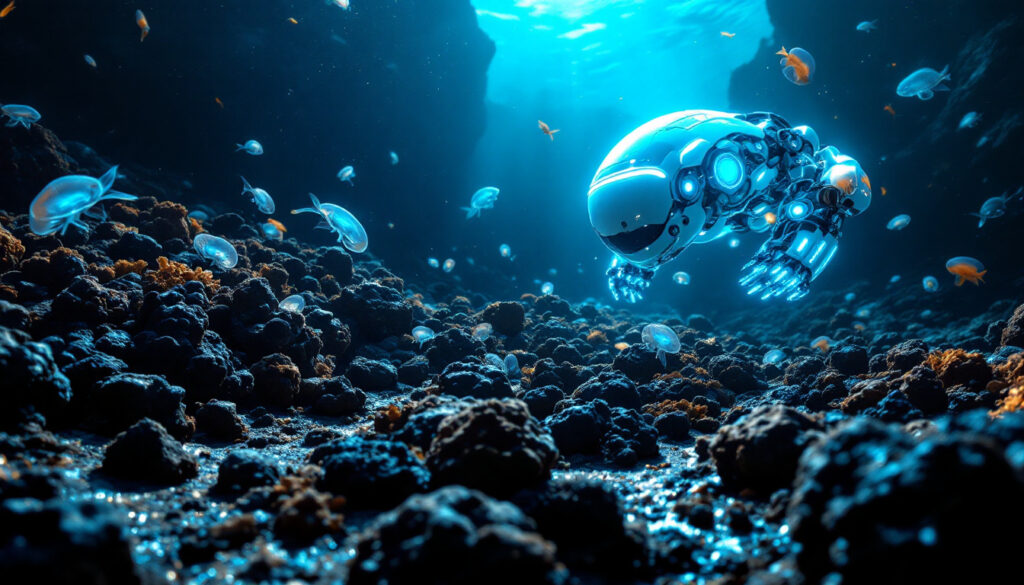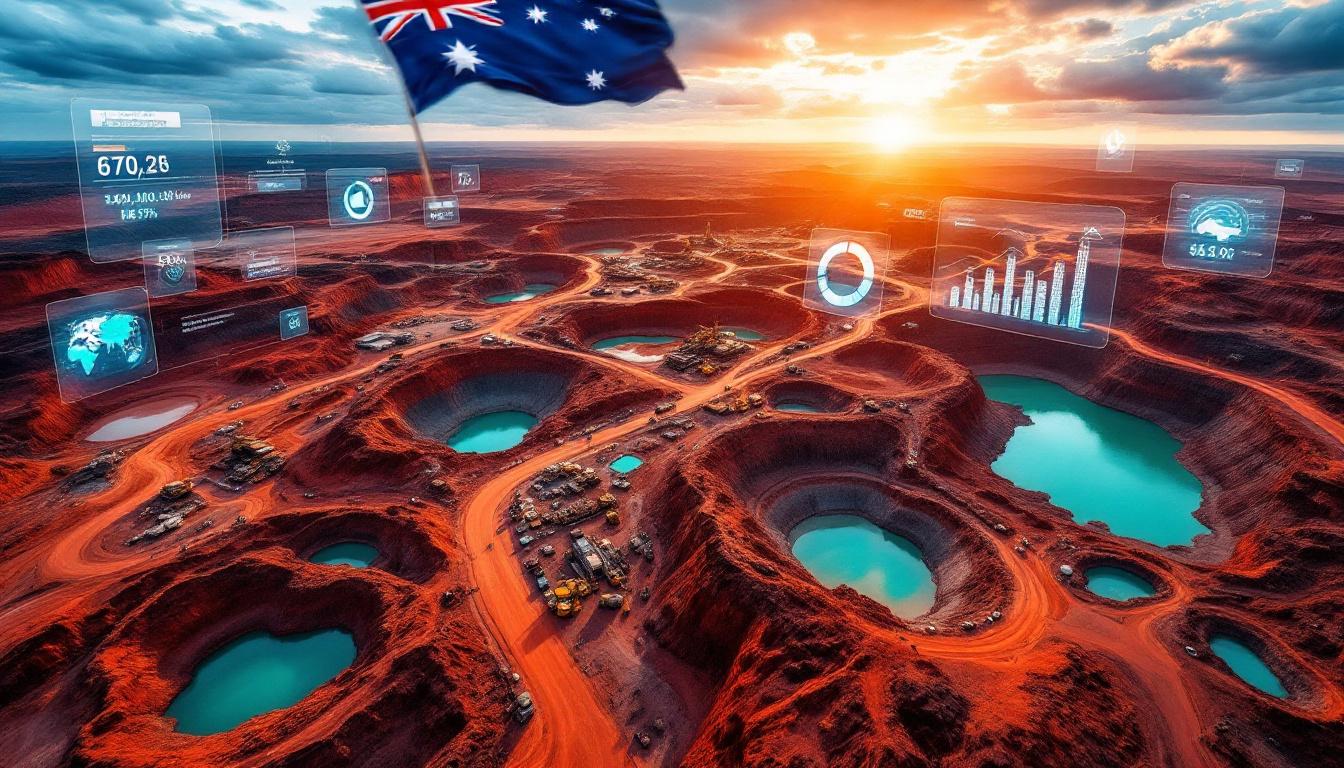Deep-Sea Mining in American Samoa: Impossible Metals' Bid for Critical Minerals
The proposed deep-sea mining initiative by Impossible Metals in American Samoa's territorial waters represents a pivotal development in global critical mineral supply chains. By targeting polymetallic nodules rich in nickel, cobalt, and rare earth elements, the project aims to reduce reliance on terrestrial mining while navigating complex environmental and regulatory challenges. The Bureau of Ocean Energy Management (BOEM) faces a May 23 deadline to initiate steps toward a potential lease sale, marking the first competitive auction since 1991. Impossible Metals' AI in mineral exploration driven robotic harvesting technology promises selective extraction to mitigate ecological disruption, though scientific consensus on deep-sea ecosystem impacts remains nascent. This initiative intersects with broader U.S. strategic efforts to secure domestic mineral supplies amid geopolitical tensions over resource dominance.
What is Deep-Sea Mining and Why is it Important?
Understanding Polymetallic Nodules
Polymetallic nodules, often described as "potato-shaped" mineral aggregates, form over millions of years through the accretion of iron and manganese hydroxides around core nuclei. These dark, lumpy formations lie scattered across vast areas of the deep ocean floor, primarily at depths between 4,000-6,000 meters.
The composition of these nodules makes them incredibly valuable in today's technology-driven economy. Typically containing 29-30% manganese, 1.5-2.5% nickel, 1-1.5% copper, and 0.2-0.3% cobalt by weight, they represent a concentrated source of critical minerals essential for electric vehicle batteries, renewable energy systems, and advanced electronics.
American Samoa's territorial waters are believed to contain one of the Pacific's richest nodule fields, particularly within the broader Clarion-Clipperton Zone (CCZ). Conservative estimates suggest nodule densities of 10-15 kg per square meter across thousands of square kilometers, representing potentially millions of tons of extractable minerals without the environmental disruption associated with land-based mining operations.
The Strategic Importance of Critical Minerals
The minerals contained in these seafloor nodules are fundamental to the global transition toward renewable energy and electrified transportation. A single electric vehicle battery requires approximately 80 pounds of copper, 56 pounds of nickel, and 24 pounds of cobalt—all present in polymetallic nodules.
Current supply chains for these minerals present significant challenges. The Democratic Republic of Congo supplies approximately 70% of the world's cobalt, often under questionable labor practices and environmental standards. Meanwhile, Indonesia and the Philippines dominate nickel production, creating geopolitical vulnerabilities in mineral security for Western nations.
Deep-sea mining offers a potential alternative that could reduce reliance on these concentrated supply sources. Industry analysts project that successful nodule harvesting operations could eventually supply up to 40% of global cobalt demand and 25% of nickel needed for EV production by 2035, potentially transforming the global critical mineral market insights.
How Does Impossible Metals Plan to Mine in American Samoa?
The Commercial Lease Request Process
Impossible Metals has submitted a formal application to the Bureau of Ocean Energy Management (BOEM) requesting exploration and potential commercial leasing rights within American Samoa's Exclusive Economic Zone. This application initiates a complex regulatory process that hasn't been fully exercised in over three decades.
BOEM faces a crucial May 23 deadline to determine "whether to initiate steps that could lead to a lease sale" for the proposed mining operation. This decision represents a watershed moment, as the agency hasn't conducted a competitive lease sale for ocean minerals since 1991, when manganese crusts off Hawaii were briefly considered for extraction.
The application process includes comprehensive environmental assessments, public comment periods, and coordination with territorial governments. Impossible Metals must demonstrate both technical capability and financial resources to execute the project while adhering to environmental protection standards.
Innovative Mining Technology
At the heart of Impossible Metals' proposal is a revolutionary approach to nodule collection that stands in stark contrast to earlier deep-sea mining concepts. Their proprietary system employs an AI-powered robotic collector equipped with advanced machine vision algorithms and articulated collection claws.
The technology distinguishes itself through its selective harvesting capability. Unlike vacuum or dredge systems that indiscriminately collect everything in their path, the AI-driven collector can identify individual nodules and differentiate them from marine life with reportedly 99.8% accuracy during trials. This precision allows the device to collect only the mineral-rich nodules while leaving surrounding ecosystems largely undisturbed.
Force-sensitive grippers apply minimal pressure during collection, substantially reducing sediment disturbance—a key environmental concern in previous deep-sea mining proposals. The system's real-time environmental monitoring capabilities allow it to adapt collection patterns based on the presence of sensitive habitats or protected species, creating what the company describes as an "environmentally adaptive" approach to resource extraction.
What Legal Framework Governs Deep-Sea Mining in American Samoa?
U.S. Territorial Waters vs. International Waters
Deep-sea mining in American Samoa falls under a fundamentally different legal regime than operations in international waters. As a U.S. territory, American Samoa's surrounding Exclusive Economic Zone (EEZ) extends approximately 200 nautical miles from its shoreline, placing these resources under U.S. jurisdiction rather than international governance.
This jurisdictional distinction means Impossible Metals does not require permission from the International Seabed Authority (ISA)—the UN-established body that regulates mining activities in areas beyond national jurisdiction. Instead, the company must navigate U.S. regulatory frameworks administered primarily by BOEM and the Environmental Protection Agency.
The legal landscape is further complicated by the United States' non-ratification of the UN Convention on the Law of the Sea (UNCLOS). While the U.S. recognizes many UNCLOS provisions as customary international law, its non-party status creates potential regulatory asymmetries and legal uncertainties, especially regarding environmental obligations and benefit-sharing requirements.
Potential Regulatory Changes
The White House is reportedly considering an executive order that would formalize a pathway for American companies to conduct deep-sea mining outside the ISA framework, even in international waters. This potential policy shift reflects growing concerns about critical mineral supply chains and could create significant competitive advantages for U.S.-based operations.
Legal experts suggest such an order would likely reference the Deep Seabed Hard Mineral Resources Act of 1980, which established a domestic licensing regime for deep-sea mining by U.S. entities predating UNCLOS. Reactivating this legislative framework could create a parallel regulatory system operating alongside but separate from ISA protocols.
For companies like Impossible Metals, these potential changes could streamline approval processes and reduce regulatory burdens. However, they also raise questions about international recognition, potential conflicts with other maritime nations, and long-term legal stability for multi-billion-dollar investments in deep-sea resource development.
What Are the Environmental Considerations of Deep-Sea Mining?
The Environmental Debate
The environmental implications of deep-sea nodule collection have sparked intense scientific and policy debates. Proponents emphasize the comparative advantages over terrestrial mining, noting that nodule collection eliminates the need for deforestation, open-pit excavation, and tailings dams that characterize conventional mining operations.
Lifecycle assessments suggest deep-sea nodule processing may generate 35-40% fewer CO₂ emissions per ton of nickel compared to laterite ore refinement, primarily through the elimination of overburden removal (typically 3-5 tons of waste per ton of ore in terrestrial mining) and direct precipitation of metal sulfides that bypasses energy-intensive smelting processes.
However, environmental organizations and many marine scientists advocate for additional research before commercial-scale operations begin. They highlight knowledge gaps regarding recovery rates of deep-sea ecosystems, potential disruption of carbon sequestration functions, and the cumulative impacts of sediment plumes on filter-feeding organisms.
The scientific understanding of deep-sea environments remains limited, with new species regularly discovered during exploration activities. This biodiversity, coupled with the extreme slow growth and reproduction rates of abyssal organisms, creates significant uncertainty about ecosystem resilience following commercial resource extraction.
Environmental Monitoring and Protection Measures
Impossible Metals has proposed a comprehensive environmental management framework centered around their AI-driven selective harvesting system. The technology employs multiple sensing modalities, including stereo cameras, acoustic sensors, and spectral analysis to identify nodules while avoiding biological structures.
Proposed environmental safeguards include the establishment of 400m² buffer zones around active harvesting sites, acoustic monitoring of cetacean populations within 50km radii, and monthly ROV inspections to track seabed recovery rates. The company's collection strategy emphasizes spatial distribution, targeting less than 5% nodule removal per square kilometer to maintain habitat continuity.
Independent researchers have documented slow regeneration rates in harvested zones, with certain protist colonies recovering at just 1.2cm per year—suggesting century-scale timelines for full ecosystem restoration. This has prompted calls for extensive protected zones and harvesting limits based on ecosystem function rather than maximum resource recovery.
Compared to traditional mining operations, which can permanently transform thousands of hectares of land, the deep-sea approach offers potential advantages in habitat preservation. However, the novelty of the environment and the technologies involved necessitate robust, independent monitoring programs to verify environmental performance claims.
What Could This Mean for the Critical Minerals Supply Chain?
Economic Implications
The development of deep-sea mining capabilities in American Samoa could significantly reshape global critical mineral markets. Analysts project that successful nodule harvesting operations could eventually reduce cobalt prices by 15-20% through increased supply diversity, potentially accelerating electric vehicle adoption by lowering battery costs.
BOEM's royalty structure mandates 27% revenue sharing with territorial governments, which could inject $120-$180 million annually into American Samoa's economy based on projected mineral prices. This represents a transformative economic opportunity for a territory currently dependent on tuna processing and limited tourism.
Workforce development initiatives, including partnerships with the American Samoa Community College, aim to train 500 local technicians in subsea robotics maintenance by 2027. The project also promises to create approximately 300 direct jobs in operations and logistics, plus additional positions in supporting industries.
Reducing dependency on foreign suppliers—particularly from regions with geopolitical instability or questionable labor practices—aligns with broader U.S. strategic goals of mineral security. The Defense Department has identified several nodule-contained minerals as critical to national security, further elevating the strategic importance of developing domestic supply chains.
Future of Deep-Sea Mining
If BOEM initiates the leasing process following their May 23 decision deadline, Impossible Metals could begin limited-scale pilot operations by late 2025, with potential commercial production ramping up between 2027-2029. This timeline assumes successful environmental permitting and technological validation during intermediate testing phases.
The scalability of the selective harvesting approach remains a key question, with the company targeting eventual production of approximately 1.2 million tons of nodules annually—enough to supply materials for roughly 1 million electric vehicle batteries per year. Equipment reliability in the extreme pressure environment (400+ atmospheres) represents a significant engineering challenge.
Beyond American Samoa, similar deep-sea mining opportunities exist within U.S. territorial waters surrounding Hawaii, Guam, and other Pacific possessions. The outcome of this pioneering project could establish regulatory precedents and technological standards for an entirely new resource industry with geopolitical shift strategies and global implications for critical mineral access.
FAQ About Deep-Sea Mining in American Samoa
What minerals are found in deep-sea nodules near American Samoa?
Polymetallic nodules in American Samoa's waters contain a diverse mineral portfolio dominated by manganese (29-30% by weight) and iron (6-8%). Their strategic value, however, derives primarily from four critical battery metals: nickel (1.5-2.5%), copper (1-1.5%), cobalt (0.2-0.3%), and manganese dioxide, which is increasingly important for next-generation battery chemistry.
The nodules also contain trace amounts of rare earth elements including neodymium, dysprosium, and praseodymium—critical components in permanent magnets for electric motors and wind turbines. These concentrations are generally lower than those found in terrestrial rare earth deposits but represent potential byproduct recovery opportunities during processing.
Compared to land-based laterite and sulfide ore deposits, nodules offer advantages in mineral accessibility (requiring no overburden removal) and reduced processing complexity due to the absence of arsenic, uranium, and other problematic elements often found in conventional ores.
How might deep-sea mining affect local communities in American Samoa?
The economic impacts for American Samoa could be substantial, with projected royalty payments of $120-180 million annually representing approximately 25% of the territory's current GDP. Infrastructure development, including potential processing facilities and port improvements, could create additional indirect economic benefits.
Environmental considerations for local fisheries focus primarily on potential impacts to pelagic species from increased vessel traffic and noise, rather than direct effects on commercial stocks, which inhabit shallower waters than the abyssal mining zones (4,000-6,000 meters deep). Monitoring programs would track potential bioaccumulation of disturbed sediments in the food chain.
Community engagement processes include required consultation with traditional leaders (matai) and collaboration with the American Samoa Department of Marine and Wildlife Resources. The project's social license depends heavily on demonstrating tangible benefits for local communities while respecting traditional Polynesian connections to ocean resources and ensuring transparency in environmental management.
What is the timeline for potential mining operations?
The regulatory process begins with BOEM's May 23, 2024 decision on whether to initiate the leasing process. If approved, this would trigger environmental impact assessments and public comment periods lasting approximately 12-18 months.
Technical development phases include shallow-water testing of collection systems (already underway), followed by deep-water pilot operations at approximately 10% of commercial scale. These validation phases would likely occur through 2025-2026, with data collected informing the final commercial system design.
Commercial operations could begin as early as 2027-2028, with gradual scaling to full production capacity by 2030. The project anticipates a minimum 30-year operational lifespan based on currently identified nodule resources, though exploration activities would continue to identify additional viable collection areas throughout the territorial waters.
As digital mining innovations continue to advance, operations could become increasingly efficient, potentially addressing some of the mining industry ESG challenges that currently concern regulators and environmental groups.
Ready to Spot the Next Major Mineral Discovery?
Gain immediate notifications on significant ASX mineral discoveries with Discovery Alert's proprietary Discovery IQ model, turning complex deep-sea mining and exploration data into actionable investment insights. Discover why major mineral discoveries can lead to significant market returns by exploring Discovery Alert's dedicated discoveries page and position yourself ahead of the market.




